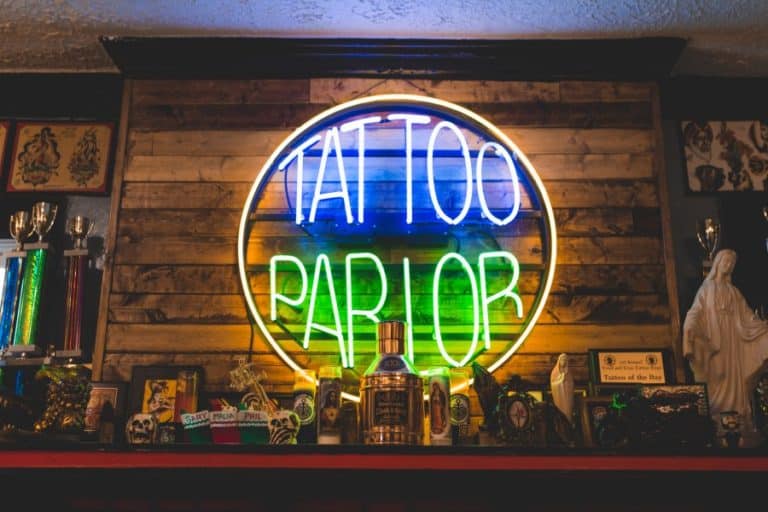Congratulations, you’ve decided that you are ready to get your first tattoo. You’ve chosen the style and subject, and now you just need to consult with an artist and book your appointment. There are many things that tattoo shops and artists wish their clients knew before coming in to book a session. A considerable contention between client and artist is the tattoo deposit. Surprisingly, some people fight their shop and artist over why a deposit is needed.
Why do tattoo shops ask for a deposit? Tattoo shops ask for a deposit as an agreement that the artist is going to be available on that particular day and time. The agreement is also on the client committing to showing up on that specific day and time.
The deposit for a tattoo is similar to having work done on your house, buying a car, and booking a venue for your child’s birthday party. When your contractor is asking for a deposit, they are looking for capital to start the project. The venue is putting your party in their books, so they want you to show up on the day they designated for your party. The dealership is putting the vehicle on hold for you to purchase.
Your tattoo artist is going to take time drawing your design and blocking time for your tattoo. Artists are not paid by the hour; they are paid for the piece they are creating for you when they tattoo it for you. The artist would be stuck with wasted time; they are not working due to a canceled appointment.
Even worse, some artists live far away and would have gone to work and back for nothing. They would be losing money at that point. Unfortunately, we are no longer living in a time where people’s words mean something.
Does the deposit go towards the cost of the tattoo?
Yes, the deposit goes towards the cost of the tattoo. The deposit is applied when the tattoo is completed. If the tattoo requires multiple sessions, the deposit will be applied to the last session. It is not as simple as you do not show up, and therefore the artist has done nothing for your scheduled appointment. The cost of the tattoo for an artist starts accumulating before you arrive in the shop to get the tattoo applied to your body. The tattoo artist can spend hours of their time drawing your design, they need to spend money on supplies, and they accumulate cost to get to and from the shop.

Ace begins to design the tattoo he discussed, and it takes him an hour-and-a-half to complete. Next, he sends Karen and email with the design, and she asks for minor changes in the drawing.
It takes Ace thirty-minutes to change, and Karen is thrilled with the results. We now fast forward to the day of the appointment, Ace sets up his station and gets ready for Karen. Karen is a no call no show.
Per the policy that this particular shop, Ace gets 50% of Karen’s deposit for her not showing up. Ace has made $100 for his two-hours of drawing plus the cost of the materials for the tattoo. Ace lost out on four-and-a-half hours worth of work and the full $600. Now he can’t pay for his son to go to the camp. Karen then calls her credit card company and puts in a claim because she never got the tattoo.
The shop now needs to call the credit card company and prove that Karen knew that the deposit was non-refundable. The credit card company sides with Karen and reverses the charge. The shop allows Ace to keep the $100 because it’s not his fault Karen bailed. Now Karen decides that she wants to get a $60 version of the $600 tattoo initially discussed in the consultation. Ace is happy to do the tattoo. Now he is making $30 minus the cost of supplies; let’s say $10. He spent two-and-a-half hours on a $60 tattoo. Based on this, Ace probably has made a profit of $8 on Karen.
If you have ever wondered why most tattoo shops only take cash, check out my article located here!
Why am I paying a deposit and a drawing fee?
The terms deposit and drawing fee are often used interchangeably, which can confuse people getting their first tattoo. A deposit is customarily putting money down to hold your spot on the calendar. A drawing fee is associated with the effort of creating a design, ensuring the artist is paid for the work of drawing.
Deposits can cover your artist drawing up your design for you. When you are booking your appointment, it is important to understand what your money is precisely paying for in regards to your tattoo. Ask questions to understand the type of fee and terms fully. You can also accumulate a separate drawing fee for a couple of reasons.
- Change your mind and want another design after the artist is done with the drawing your consultation initially covered.
- Ask for more than three changes to the drawing. Your artist wants to nail the design but makes sure to keep your notations clear and specific to avoid unnecessary redrawing.
- You ask for significant changes that were not discussed at the consultation appointment.
How much of a deposit is expected, can I get it back?
Tattoos are not, and should not be, cheap. Even the small delicate infinity symbol on your wrist is going to cost you at least $65. Depending on the shop, the amount of the deposit can vary. You should expect to pay at least $50, the shop minimum, or up to one hour of the artist’s hourly rate. The deposit is non-refundable, so it cannot be refunded for any reason. With the right amount of 
Each artist’s hourly rate can be vastly different. The hourly rate can be higher based on experience, popularity, education, and location. Tattooing is a client-based business, which makes you in charge of who tattoos your body.
Have several consultations, so you are 100% comfortable on who is tattooing. Once you feel right about who will be tattooing and the design, a deposit will be worth the final product.
The deposit is forfeited to pay the artist for their time regardless of the reason. The deposit is used to compensate the artist for the time they spent working for your tattoo. You will lose your deposit if you are a no show.
If you call to reschedule your appointment, a new deposit is going to be required. If you cancel and do not reschedule, you will lose the deposit. If the tattoo is never done, then work that was completed in person or via email was done without pay.
It is usual for a shop to have a waiting list going for when circumstances arise for a tattoo appointment to be rescheduled. Your specific time needs to be taken by someone; most people have work and child commitments and cannot show up to get tattooed at a moment’s notice.
A standard policy is 48 -72 hours to reschedule a booked appointment. You will lose your deposit if you are more than 15 minutes late, even if you call prior. Artists have back-to-back clients, being late makes all there other sessions late. Your time slot includes:
- Edit/resize the tattoo design to fit your body.
- Apply the stencil.
- Assemble tattoo equipment and open sanitary supplies in front of you.
- All breaks you request.
- Tattooing time.
You can also lose your deposit if you show up to your session and decide on a completely different tattoo. That tattoo is now going to require more drawing time, prep time, and ultimately will shift the time they can tattoo you. You will not be tattooed and ultimately lose your deposit if you show up intoxicated or with a minor. The shop needs your full and sober consent to tattoo you. A tattoo shop is not a child-friendly place.
The bottom line, tattooing an art form. If you go to a gallery and purchase a piece of art, you are paying the artist for their work. Your tattoo is a custom piece of art you are displaying on your body instead of in your home. The artist needs to be paid for the time they spend working. That includes the drawing to placing it on the skin. Don’t be a Karen, and be sure to tip your artist.

